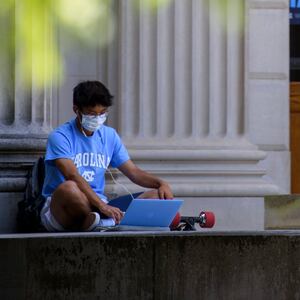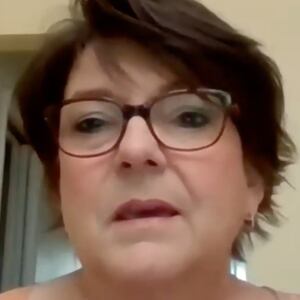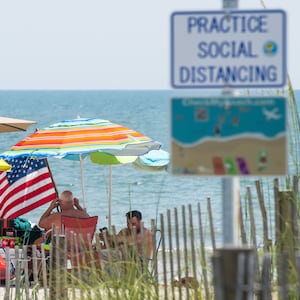As millions of Americans prepare to travel for Labor Day, health experts fear the holiday weekend will cause a COVID-19 spike in areas that are already hot spots—and could determine how the deadly virus spreads in the coming months.
To date, 186,834 have died and 6,153,735 more have been infected with the coronavirus, numbers that will only increase as the United States heads into fall—and with it, flu season. In anticipation of the potentially devastating combination of COVID-19 and the flu, epidemiologists and state officials are pleading with Americans to stay home and avoid large gatherings despite pandemic fatigue.
“We don’t want to see a repeat of the surges that we have seen following other holiday weekends,” White House coronavirus adviser Dr. Anthony Fauci told CNN on Thursday, referring to the surge in new cases after Memorial Day and the Fourth of July. “We don’t want to see a surge under any circumstances, but particularly as we go on the other side of Labor Day and enter into the fall.”
ADVERTISEMENT
According to an NBC News analysis, the United States saw more than 276,093 new cases of coronavirus in the two weeks after the Fourth of July holiday weekend. After Memorial Day, more than a dozen states and Puerto Rico recorded their highest daily case averages and hospitalization rates.
Dr. William Schaffner, an infectious disease doctor at Vanderbilt University Medical Center, stressed the case increase is common after holiday weekends as people are more likely to spend time with large groups without masks and ignore social distancing.
“We’re going to have the ‘careful’ people and the ‘carefree’ people—and I’m afraid we’re going to have too many carefree people this Labor Day weekend taking advantage of the last bit for the summer,” Schaffner said. “They’re going to be doing it without masks, not social distancing, they will be enjoying a lot of adult beverages in close quarters, and I think it’s going to be an accelerant for new cases.”
One major concern, he told The Daily Beast, is that some local officials—especially in Tennessee—have allowed mask mandates and other social-distancing measures to expire.
“We have to maintain mask-wearing over the long haul. This is a marathon, not a sprint. I’m worried for sure. We’re definitely going to see an increase and we’re going to see new hot spots emerge,” Schaffner added. “Have fun, be careful, please wear the masks and when you do something fun with relatives and neighbors—please do it in small groups.”
Some state officials have been dedicated to ensuring cases continue to decline, warning residents and incoming visitors about travel restrictions and health guidelines. In July, the United States saw a daily case rate of about 70,000. That eye-popping number has since fallen to 40,000 and hospitalizations rates are down 37 percent.
“We have to go into the fall with decreasing cases like we’re doing now. We can’t risk a lack of personal responsibility,” Adm. Brett Giroir, the assistant secretary for health at the U.S. Department of Health and Human Services, said in a Tuesday call to reporters, according to CNBC. “Why are we seeing this success? Because the national strategy is working.”
While several states hit hardest over the summer—including California, Texas, and Florida—are seeing a hopeful decline in cases, others in the Midwest are in the midst of a COVID-19 surge. Centers for Disease Control and Prevention Director Dr. Robert Redfield has warned that America’s heartland “is getting stuck” as cases start to plateau.
“I think new cases may be accentuated in the Midwest because of the recent spread of cases, but I also think it would be naive to think every place across the country won’t get an uptick from Labor Day,” Schaffner said.
To combat the potential uptick in Minnesota, Gov. Tim Walz on Thursday urged residents to continue to follow health guidelines during Labor Day, stressing the holiday weekend could be a tipping point for the state, which is already in a “precarious situation.” Despite calls from Republicans to fully open the state, Walz said federal health officials have told him there are troubling warning signs in Minnesota, similar to those in Arizona before its massive outbreak. As a result, he’s refused to loosen restrictions before the summer holiday.
“Six months ago it was my hope that we would be back to doing all of those things we talked about—going to the State Fair, watching high school football, gathering to watch the Gophers on Saturday,” Walz said. “Well, the virus has not allowed us to do that, and we have to remain vigilant. We have got to stick with this.”
In Massachusetts, officials are reminding the public about travel orders that the state has instituted for all visitors. Travelers from 34 states, Washington, D.C., and Puerto Rico must also self-quarantine for two weeks after arriving in New York, New Jersey, and Connecticut.
In California, where a dangerous heat wave is expected to hit over the weekend as the state battles wildfires and consistently high COVID-19 case rates, officials are worried about large crowds. A Santa Cruz county spokesperson confirmed to The Daily Beast that to help mitigate the spread, all of the beaches in the area will only be open for four hours on Saturday and Sunday, from 4 p.m. to 8 p.m.
“This is not a Labor Day weekend that will be full of celebrations,” Los Angeles Mayor Eric Garcetti said this week. “You need to cancel all plans for gatherings.”
The White House is also concerned about the inevitable surge of new cases after Labor Day. Ohio Gov. Mike DeWine, whose state saw a positive rate of 6.5 percent after the Fourth of July, said Vice President Mike Pence asked state leaders to encourage residents to be safe during the upcoming long weekend. “They have grave concern about Labor Day coming up,” DeWine said Tuesday. “We can get together. We can have fun, but we have to be very, very careful.”
Even Georgia Gov. Brian Kemp, who has controversially been one of the leading voices in favor of reopening the country, is begging residents to celebrate safely this weekend. On Friday, Kemp and his wife embarked on a statewide tour to encourage “four things for fall” that will stop the spread of the deadly virus.
Kemp did a similar tour just before the Fourth of July weekend.
“One, continue to socially distance yourself. Number two, if you can do that, wear your mask. Continue to wash your hands, clean surfaces, and use those best practices that we have talked about during the entire pandemic,” Kemp said Friday. “And finally, please follow and let’s enforce the existing guidelines that we have that was developed by our public health officials in the executive orders that we have.”
State officials are also worried about the potential surge in COVID-19 cases at colleges that are opening up after the holiday weekend, as universities are already struggling to contain their outbreaks.
Dr. Helmut Albrecht, chairman of the Department of Internal Medicine at the University of South Carolina in Columbia and Prisma Health, told The Daily Beast that administrators at his university are already dealing with over 1,000 positive cases and are “worried” about the holiday weekend. He believes that given the current trajectory of cases—and the inevitable partying that will happen over Labor Day weekend—the university may soon become overwhelmed with sick students and administrators.
“The students are a real problem for the community. They can be asymptomatic and if they are‚ they will not curb their social mobility at all,” Albrecht said. “And with all these parties that will be happening this weekend... we’re worried. If we have thousands next week, we will be overwhelmed, and we’re not prepared for what may happen.”
But despite the many pleas from state officials to heed caution this weekend to prevent another wave of COVID-19 cases, Americans are still taking risks, and even traveling across the country to soak up the last days of warm weather.
“Florida this year is claiming the lion’s share (plurality) of Labor Day flight reservations, with 12 percent of all plans including a destination in the Sunshine State,” according to the travel site TripIt, which noted that Labor Day flight bookings are only around a third of 2019’s numbers. The surge in flights to the Sunshine state—particularly Orlando, Tampa, and Fort Lauderdale—comes as the Florida Department of Health on Friday reported over 640,000 total coronavirus cases in the state.
A spokesperson for the Transportation Security Administration told The Daily Beast that 887,698 travelers passed through airport checkpoints on Thursday—a tenfold increase from April 14. In comparison, approximately 2,110,000 travelers went through the airport on the same date last year.
But for Matthew Meltzer, a freelance travel writer who is flying from Kentucky to Miami this Labor Day weekend to visit friends, traveling to a city still besieged with COVID-19 cases is worth it. “I understand there’s a lot of cases, but it’s just a risk you run,” Meltzer told ABC News. “Life is full of risks.”








